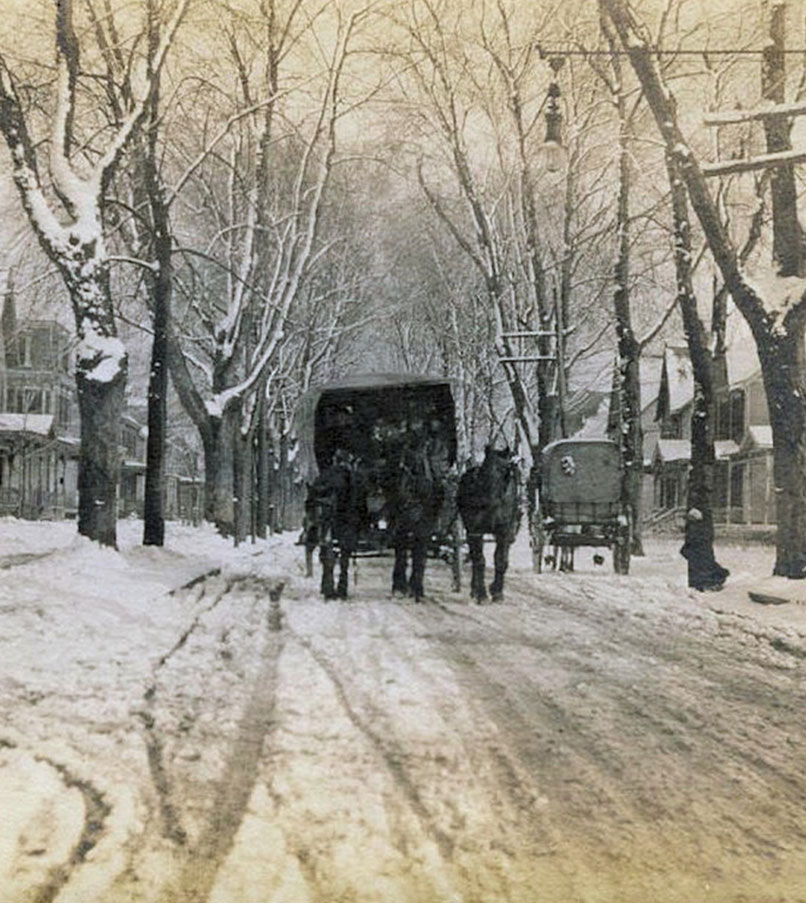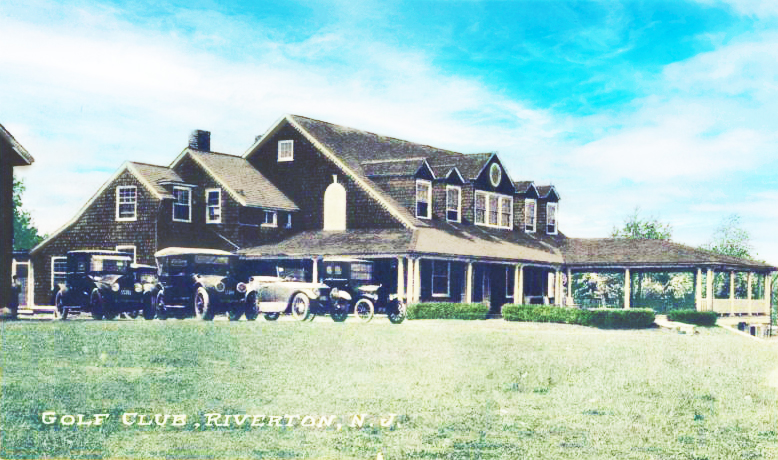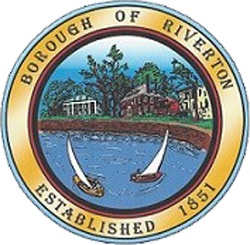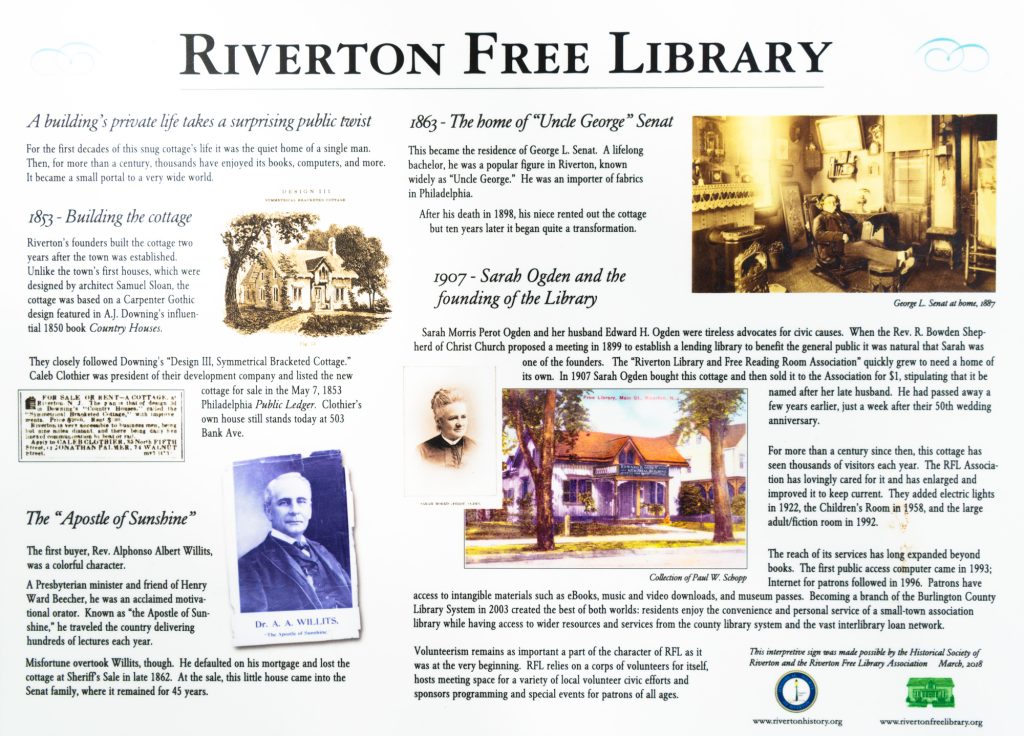History
Riverton Borough History
Riverton, in Burlington County, New Jersey, is a small residential community on the Delaware River approximately ten miles north of Philadelphia. It was founded in 1851 by a group of ten Philadelphians for summer homes for their families.
Robert & William C. Biddle, Caleb & James Clothier, Dillwyn & William D. Parrish, Rodman Wharton, Daniel L. Miller, Jr., Chalkley Gillingham, and Prof. Charles D. Cleveland. This group, most of whom were Quakers, had discussed such a project for some time as industrialization along the Schulylkill River in Pennsylvania made that region less desirable. They wanted a site offering country living with easy access to Philadelphia. Riverton offered both.
Noted architect Samuel Sloan was commissioned by the group to design a village, to be named Riverton, on 120 acres of land to be purchased from Joseph Lippincott in the old township of Chester. The tract lay between the Delaware River and the Camden & Amboy railroad. The design called for building a seawall & landscaping to the riverfront, adding a pier suitable for commerce and passengers, and a railroad station at the northern end of town.Other than one small building near the railroad for information, fishing licenses and some supply deliveries, there were no provisions for industry of any kind.
Borough Historian
Roger Prichard
Mr. Paul Schopp, former Borough Historian, and the Riverton Historical Society have kindly provided information and photographs for this website. We are always looking to obtain old photographs and other ephemeral items related to Riverton.
Please see our website for further information: rivertonhistory.com
According to architectural historian Henry Russell Hitchcock, Riverton
was the first totally planned residential subdivision in America.
Within five months of its purchase in January 1851, the riverfront was developed as planned. The river pier was in use. Four streets had been opened. Work had begun on the Sloan-designed villas of the founders and others. By fall eight of the homes were completed and occupied. The founders sought incorporation as The Riverton Improvement Company. For twenty years, beginning in March 1852, the Corporation held the right to issue deeds for the village and add to the original acreage which would also become a part of Riverton. The Deeds carried special restrictions, notably the liquor clause, prohibiting the sale or manufacture of liquors on any property in the village. Even though it was owned and maintained by river-front home owners,
The riverbank was kept open for the enjoyment of all. One clause also prohibited erection of any permanent structure on the riverbank. For more than a hundred years this clause allowed activities such as concerts, fireworks, political speeches, and boat watching on the grass to be enjoyed by all. then Memorial Park opened in 1931 many activities moved to that location. Memorial Park was dedicated to honor all servicemen and women of the US armed forces. Over 12 acres in size, it offers picnic areas and a playground along with baseball diamonds, basketball & tennis courts, and soccer fields. It is the site of various celebrations, one of the most popular being the ending place of the annual Children’s Flag Parade on the 4th of July, a tradition begun in 1897 by the Yacht Club.
The Riverton Yacht Club was organized in 1865. In 1880 it erected a clubhouse on the pier. It is the oldest Yacht Club on the Delaware and one of the oldest in the country. Now more than 150 years old, the pier is the last remaining steamboat landing on the Delaware River. Although no longer used by paddlewheel steamboats it has remained in constant use. Today sailing enthusiasts call it home. The stick-style clubhouse is often the subject of photographers and painters.

Photo credit to the Riverton Historical Society: rivertonhistory.com
With the transition of Riverton from a summer resort to a permanent community, a movement grew for independence from its parent township of Cinnaminson. In 1865 Cinnaminson had separated from Chester township and taken Riverton and several other small villages with it. In December 1893 a special election was held and the decision to become a borough was unanimous. Edward H. Ogden became Riverton’s first mayor and a four-man borough council was elected and installed on January 1, 1894. At their first meeting boundaries of the borough were established for the first time. The Council meetings were held at the fire house. This custom continued until 1989 when a new Municipal building was erected. The Historical Society donated a pair of platform lights to flank the entrance that had once graced the old railroad station.
Churches were soon established in Riverton, the first being Christ Episcopal in 1854. Their first church was consecrated in 1859. Its beautiful brownstone building erected in 1884 is on Main and Fourth streets. The rose window facing Main was made by Louis C.
The rose window facing Main was made by Louis C. Tiffany and donated in the memory of Louis Godey by his son and daughter. Godey (1804-1878) was the publisher of America’s first women’s magazine and summered here for many years.The Porch Club, a women’s club formed in 1890 and named for its informal meeting place of residences porches, is one of the oldest in New Jersey. It was instrumental in making many social improvements happen in Riverton.
Through their efforts the first public Kindergarten in the county was opened in 1896. Two years later the first woman was elected to the School Board. And in 1900 they sent invitations throughout the State for a gathering in Riverton for the purpose of forming a State Mother’s Circle. In October of that year a successful meeting was held and the circle was formed and later became known as the N.J. State Parent and Teacher Association (PTA). The Club outgrew conducting their meetings on porches and in 1909 had their own building erected on Howard Street. Today their members continue to play an active role in community and regional activities.
The Riverton Free Library, which began in 1890’s, is still housed in the Carpenter style cottage on Main Street that was donated in 1908 by Mrs. Edward H. Ogden in memory of her husband, Riverton’s first mayor. The cottage, erected in 1852 and enlarged several times, is a part of the County Library System.
Riverton Country Club was founded in 1900. It is one of the earliest golf clubs in the country. Its 18-hole course is challenging, and beautifully maintained. In 1905 a small half-way house with bowling alley and snack shop was erected adjacent to the club’s entrance on Park Avenue. The bowling teams continue their activities in the original location.
In 1959 the original clubhouse was razed and a new, larger one was erected on the club grounds within Cinnaminson Township. They also offer tennis, swimming, fine dining and banquet facilities.

Photo credit to the Riverton Historical Society: rivertonhistory.com

Photo credit to the Riverton Historical Society: rivertonhistory.com
Riverton has always had interesting and notable people who have chosen to live here.
One of the earliest was John Fraser back in the 1850’s. He was a famous architect and founder of the Pennsylvania Institute of Architects and the Philadelphia Chapter of the A.I.A. He designed many buildings including the Union League in Philadelphia and Christ Episcopal Church and Rectory in Riverton. He had offices in Philadelphia and Washington D.C. but his home remained Riverton until shortly before his death in 1902.
Isaiac Clothier, son of Founder Caleb Clothier was a resident. He entered into a partnership with his friend Justus Strawbridge in 1862. They founded the distinguished department store Strawbridge & Clothier in Philadelphia. Maxfield Parrish, artist, spent summers and vacations here during his youth with his grandfather Dillwyn Parrish (a Riverton founder) and other relatives whose homes were in Riverton. Joseph Campbell, for whom the soup company was named, lived here from 1872 until his death in 1900. Several members of the Dorrance family, who had joined and later taken over Campbell’s Soup, also lived here. The John Bioren family of banking and stock exchange note lived here for more than a generation. Franklin D. Olier, who organized the American Legion in Paris in 1918 lived on Park Avenue. The Hollingshead family had lived in Riverton for many years when son Richard developed a ‘drive-in’ movie. The first drive-in opened June, 1932 in Camden NJ. During the height of the Pennsylvania Railroad, many of its executives lived in or visited Riverton. This might explain why special trains were often run to Riverton for events like bicycle racing in the 1890’s, and flower shows at Dreer’s Nursery for many years.
The Henry A. Dreer Company had their main office and trial gardens in Riverton from 1868 until 1944. They hybridized and developed many varieties of flowers, grasses, and vegetables. People came from the world over to study horticulture at their Riverton nurseries and to see the gardens in bloom from Spring until late Fall. Special flower shows were held at the height of the seasons. With the loss of three head executives within a short period of time and other circumstances, Dreer’s closed in 1944. This was the last section of Riverton to be developed into residential lots.
Riverton today is almost fully developed. The population is stable at slightly more than 3,000. Changes in population are due primarily to generational cycles. Riverton is governed by elected officials; a Mayor, six Borough Council members, and various appointed committees. Riverton has Police and Volunteer Fire Departments and regular collections of trash and recyclable materials. There is an elementary school that was established in 1865, also, Nursery School, Daycare facilities, Rotary, and Lion’s Clubs. Neighboring communities of Palmyra and Cinnaminson along with Riverton are referred to as the Tri-Boro Area and share some services and activities.
Over the years a small and vital business district has developed in the center of town. Offices and shops offer a variety of services and wares. Included are a tea-shop, deli, bakery, fitness center, post office and bank among others. In a pedestrian town such as Riverton all are easily reached on foot. In addition, the new River Line light-rail service has a station right in the center of town. It runs over the old steam-train route between Camden and Trenton making commuting to work or attending events anywhere between Philadelphia and New York possible.
Riverton has expanded gradually and systematically over the decades. Within its 3/4 of a square mile area neighborhoods display more than 150 years of American architectural styles. Six Victorian styles are represented in the earliest part of Riverton. Those of the twenty-first century are found east of the railroad. More than half of Riverton’s buildings are included in the State and National Directories of Historic Places. Fine old trees, and some streets still lit by gaslights of a century ago help to make Riverton an attractive place to live.
Copies of a self-guided walking tour of the oldest section of Riverton are available at the Riverton Library or from the Historical Society of Riverton.

